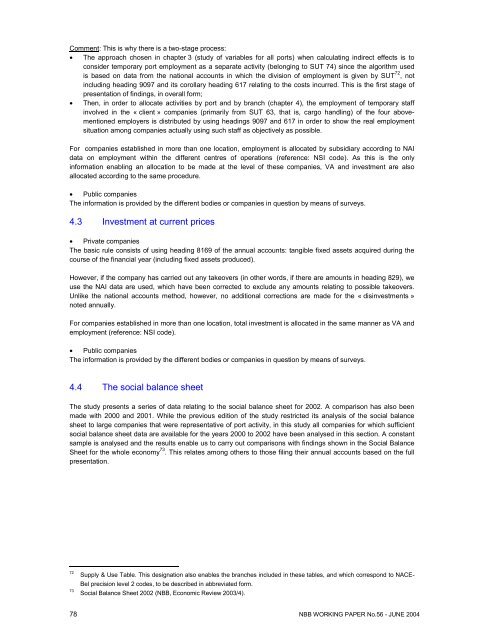Economic importance of the Flemish maritime ports: Report 2002
Economic importance of the Flemish maritime ports: Report 2002
Economic importance of the Flemish maritime ports: Report 2002
You also want an ePaper? Increase the reach of your titles
YUMPU automatically turns print PDFs into web optimized ePapers that Google loves.
Comment: This is why <strong>the</strong>re is a two-stage process:• The approach chosen in chapter 3 (study <strong>of</strong> variables for all <strong>ports</strong>) when calculating indirect effects is toconsider temporary port employment as a separate activity (belonging to SUT 74) since <strong>the</strong> algorithm usedis based on data from <strong>the</strong> national accounts in which <strong>the</strong> division <strong>of</strong> employment is given by SUT 72 , notincluding heading 9097 and its corollary heading 617 relating to <strong>the</strong> costs incurred. This is <strong>the</strong> first stage <strong>of</strong>presentation <strong>of</strong> findings, in overall form;• Then, in order to allocate activities by port and by branch (chapter 4), <strong>the</strong> employment <strong>of</strong> temporary staffinvolved in <strong>the</strong> « client » companies (primarily from SUT 63, that is, cargo handling) <strong>of</strong> <strong>the</strong> four abovementionedemployers is distributed by using headings 9097 and 617 in order to show <strong>the</strong> real employmentsituation among companies actually using such staff as objectively as possible.For companies established in more than one location, employment is allocated by subsidiary according to NAIdata on employment within <strong>the</strong> different centres <strong>of</strong> operations (reference: NSI code). As this is <strong>the</strong> onlyinformation enabling an allocation to be made at <strong>the</strong> level <strong>of</strong> <strong>the</strong>se companies, VA and investment are alsoallocated according to <strong>the</strong> same procedure.• Public companiesThe information is provided by <strong>the</strong> different bodies or companies in question by means <strong>of</strong> surveys.4.3 Investment at current prices• Private companiesThe basic rule consists <strong>of</strong> using heading 8169 <strong>of</strong> <strong>the</strong> annual accounts: tangible fixed assets acquired during <strong>the</strong>course <strong>of</strong> <strong>the</strong> financial year (including fixed assets produced).However, if <strong>the</strong> company has carried out any takeovers (in o<strong>the</strong>r words, if <strong>the</strong>re are amounts in heading 829), weuse <strong>the</strong> NAI data are used, which have been corrected to exclude any amounts relating to possible takeovers.Unlike <strong>the</strong> national accounts method, however, no additional corrections are made for <strong>the</strong> « disinvestments »noted annually.For companies established in more than one location, total investment is allocated in <strong>the</strong> same manner as VA andemployment (reference: NSI code).• Public companiesThe information is provided by <strong>the</strong> different bodies or companies in question by means <strong>of</strong> surveys.4.4 The social balance sheetThe study presents a series <strong>of</strong> data relating to <strong>the</strong> social balance sheet for <strong>2002</strong>. A comparison has also beenmade with 2000 and 2001. While <strong>the</strong> previous edition <strong>of</strong> <strong>the</strong> study restricted its analysis <strong>of</strong> <strong>the</strong> social balancesheet to large companies that were representative <strong>of</strong> port activity, in this study all companies for which sufficientsocial balance sheet data are available for <strong>the</strong> years 2000 to <strong>2002</strong> have been analysed in this section. A constantsample is analysed and <strong>the</strong> results enable us to carry out comparisons with findings shown in <strong>the</strong> Social BalanceSheet for <strong>the</strong> whole economy 73 . This relates among o<strong>the</strong>rs to those filing <strong>the</strong>ir annual accounts based on <strong>the</strong> fullpresentation.7273Supply & Use Table. This designation also enables <strong>the</strong> branches included in <strong>the</strong>se tables, and which correspond to NACE-Bel precision level 2 codes, to be described in abbreviated form.Social Balance Sheet <strong>2002</strong> (NBB, <strong>Economic</strong> Review 2003/4).78 NBB WORKING PAPER No.56 - JUNE 2004
















